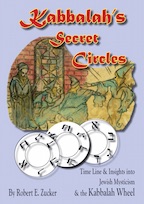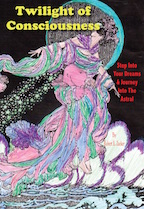|
Qabbalah: History of Kabbalah Qabbalah- history of the TraditionThis section is from the new book on Kabbalah:
The Qabbalah provides a framework of the origin and nature of life, as well as the evolution of humans and the universe. The Hebrew word Qabbalah (from Kibbel; QBL) means "to receive. It is a doctrine passed down thousands of years by oral tradition (hence, receive tradition) and printed by hand and press to preserve its symbolism. The term Qabbalah is also means "to transmit" or send, as in the Latin traditie (action of handing over). Moses received the Law (the Qabalah) on Mt. Sinai. (Pirke Abot I, I) Among the oldest writings in Jewish literature (the Mishna, Midrash, Talmud), the Qabalah encompasses the whole body of Judaic tradition. The Qabbalah is based on the belief that every word, every letter, number and event accent contained a deeper meaning known only to a few. The word Qabbalah (spelled various ways depending on the author) was first used in the 13th Century A.D. But, it's teachings have been traced back to renowned Talmudists such as Rabbi Ismael ben Elisa (about 121 A.D.), Rabbi Akiba (about 100 A.D.), Nechunja be-ha-Kahan (about 70 A.D.) and especially Simon ben Yosai (about 150 A.D.) R. Yohai is said to be the author of the Zohar, one of the fundamental writings on Qabalah. Most of the mystical aspects of the Qabbalah were derived from Parism and Neo-Platonism philosophies. These works were eventually developed into the Greek Hermetic teachings. The practice of Qabalah appeared among small practicing groups in the 6th Century A.D. The printing press gave the masses unprecedented access to the esoteric teachings. Originally, Qabbalah developed out of a reaction to the formation of rabbinical Judaism. It reached its greatest popularity in the 12th Century with authors like Abraham Abulafia. The practice of Qabalah among European Hasidic Jews was strong through the 20th Century. The two principle sources of the Qabbalah teachings are the "Sefer Yetzirah" (English: Book of Creation, or Book of Formation) and the Zohar. The Book of Creation, supposedly written by Abraham the Father of the Jewish people, is a series of monologues describing a system of numerial interpretations of the universe and its emanations. It wasn't really a book back then, but a series a parables that revealed esoteric meanings when studied correctly. It was probably first written down in the 6th Century or earlier.
The Ma-a-seh Bereshit may be today's Book of Creation. The first part of the Book of Creation covers the ten sephiroth or numbers as manifestations of intelligence. The second part establishes the Hebrew alphabet as the divine instrument of creation and the map of consciousness. The structural diagram is a set of symbols known as the Tree of Life. The second principle source of Qabalistic philosophy is the Zohar (Hebrew word for "brilliance" or "brightness"). It is also called the Book of Splendour. The Zohar is the mystical and allegorical commentary on the Hebrew Pentateuch. Moses de Leon is said to be the author in the 13th Century, but it is attributed by him to Simon ben Yohai, the great scholar of the 2nd Century. The earliest of the Qabbalistic literature is also found in the tradition of the Merkabah mystics. The "Ma-a-seh Merkabah" (Hebrew for Chariot Throne) is the vision of the Chariot Throne of G-d, which was also Ezekiel's prophetic vision of the four Cherubim. The followers were said to be from the family of the father of Moses and adopted his religion. They performed miracles and evoked spirits with the knowledge of the Word. The Ma-a-seh Merkabah forms the practical application of the Qabbalah and makes up the art of talismanic and ceremonial magic. The source we mostly use today is based on the Ma-a-seh Berashith,- the Book of Creation or Work of the Beginning. It is divided into the symbolic and literal Qabbalah. The literal Qabbalah is the mathematical interchanging (combinations or transposition) of the Hebrew letters and numbers. This is known as Gematria, Notarikan, Atbash, Albam, etc. It is also found in permutations and Torah Bible Codes.
New Books on Kabbalah and Astral Projection from Robert Zucker
Kabbalah Home PageEntertainment Magazine Page© 2006-2017 Robert Zucker Entertainment Magazine On Line / EMOL.org / AZenertain.com |

 "Twilight of Consciousness:
"Twilight of Consciousness: The
Qabbalah (also spelled as Qabalah or Kabbalah) is a system of Judaic
philosophy that examines and explains the workings of universe.
The
Qabbalah (also spelled as Qabalah or Kabbalah) is a system of Judaic
philosophy that examines and explains the workings of universe. The
foundation of the current Qabbalah arose from the ancient Jewish
writings of the Ma-a-seh Bereshith, the discipline that explained the
theories of cosmology and cosmogony. Also called cosogeny, it is the
theory about the coming into existence or origin of the universe, or
about how reality came into being.
The
foundation of the current Qabbalah arose from the ancient Jewish
writings of the Ma-a-seh Bereshith, the discipline that explained the
theories of cosmology and cosmogony. Also called cosogeny, it is the
theory about the coming into existence or origin of the universe, or
about how reality came into being.